Pottery
Then it's out to the sun to dry.
And the finished product......
Mosaic
Some of the bigger pieces photographed take months.
|
|
|
The most distinctive Moroccan pottery is made in Fes. We visited a pottery workshop as part of our Fes Old City tour. In the workshop there were two main products - pottery and mosaics PotteryFirst of all the clay has to be "made" in a process of drying, soaking and bleaching. The potter starts with a lump of clay and with his feet stepping on the big wheel below he spins it around to form a jug or bowl or whatever he wants. Then it's out to the sun to dry. All the Fassi pottery is handpainted. We watched this man paint a bowl. It took about 10 minutes. The pottery is fired in one of these special ovens. And the finished product...... .....my favourite porridge bowl! MosaicMosaics are also made in the same workshop. Think of making a giant jigsaw-forever! That's what making a mosaic seemed to be like. There are some similarities with the pottery process. The tiles have to be fired in the huge ovens. In this part of the workshop, workers have to break the tiles into small pieces for the mosaic making. The pieces are then passed onto the mosaic maker. In the photograph above he is making a frame for a mirror. This mosaic will take him days. He lays out the pieces upside down and then glues a wooden covering to the back. It is a long, slow process, requiring a lot of concentration.
Some of the bigger pieces photographed take months.
2 Comments
Driving around Marrakech and passing through the other Moroccan cities, you would think the shopping might be very similar to home. However, outside of these big cities, shopping is a lot different. Moroccans do their shopping in their local médina or souq. Most dictionaries define a médina as the old walled part of a North African town. A souq is defined as an open air market found in Asian and North African towns. As part of our tour, we had time to visit the médina's of Rabat, Fes and Marrakech. Each were interesting, busy and very loud! While initially it seems chaotic, médinas usually have sections: meat, breads, spices, fruit/veg, clothes, furniture, household items. Local people know exactly where to go to get their fresh produce for their cooking. Look closely at the photographs to identify fruit and vegetables we find on our supermarket shelves which originate in Morocco. The médina passageways are really narrow and you can only imagine how hard it must be for the shop owners to bring their produce through. Donkeys, hand carts and motorbikes are used. There doesn't seem to be any restrictions on motorised vehicles -once it fits, it's allowed to go through! There were many craft areas/workshops at the edges of the médina. In Fes and Marrakech we visited the leather souq, the furniture souq, the carpet souq and the ceramic souq. Craftsmen work on their products in their workshops. Nowadays, a display or show for tourists is ready for viewing. Usually the owner or manager with fluent English will lead tourists around the workshop explaining the process and finish in the shop where the tourists are encouraged to buy souvenirs.
Ms Treacy's favourite part of travel is of course the food and Morocco was a treat. BreakfastMy first breakfast was at the beautiful Dar Oulanda Hotel. My breakfast table was by the pool and I got my first taste of the Moroccan carb loaded breakfast! On the breakfast table we can see a lot of the usuals: coffee, orange juice, yogurt, soft cheese, chocolate spread, toast. The orange juice is freshly squeezed and orange juice stalls can be seen in many of the cities in Morocco. The coffee comes in one of the big flasks and the other big flask contains hot milk. Why do you think most of the milk on the breakfast tables in Morocco was boiling hot? In a restaurant you would order this coffee by asking for a café au lait. Lets look closely at the pancakes/pastries: On the left we have crepes or pancakes as we know them. Moving right on the bottom are Beghrir pancakes. On top is a Moroccan doughnut and to the right is the very interesting Rghaif . These square shaped Moroccan pancakes were at most breakfasts and are made by kneading a small ball of dough. Flattening and rolling it out, folding it into a square and frying it. All of these pastries and pancakes are delicious on their own or with honey, chocolate, lemon, sugar....the possibilities are endless! DinnerTaGines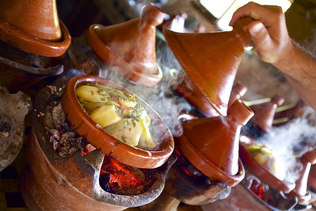 The tagine was possibly my favourite Moroccan dish. It reminds me of a stew. It comes in a pot like the one on the left. My favourite tagine was the top left-egg and meatball. You eat your tagine with bread. CouscousI didn't eat a lot of couscous in Morocco, I preferred the tagines. Generally in restaurants it was a choice of one or the other! The Couscous pictured above was my first one and the most impressive couscous I have ever seen! It is a meat couscous and there is also a lot of vegetables in it. At the bottom is the couscous which is like rice but is made from semolina. On the left is a bowl of gravy which you pour over the couscous, as much as you prefer. PastillaI only had this once in a restaurant in Fez. This pastilla is made of warga layered with chicken (often pigeon!) cooked with carmelised onions, lemon, eggs and toasted sugared almonds and dusted with cinnamon and powdered sugar. It was delicious! At the start I was wondering how this little pastry would fill me up properly for lunch but I was so full I wasn't able to finish it all. SaladsEvery dinner started with beautiful salads. Can you recognise the different vegetables? FruitBeing such a hot country, Morocco is home to a lot of interesting fruits. Can you name the fruit in the pictures? Look closely at the fruit you buy in the supermarket. It may have come from Morocco!
The Sahara Desert is the largest desert in the world. It is estimated that it is as big as the United States of America and takes in the countries of Morocco, Mauritania, Mali, Algeria, Libya, Niger, Tunisia, Chad, Egypt, Sudan and the disputed territory of Western Sahara. Read more: http://www.lonelyplanet.com/africa/travel-tips-and-articles/77633#ixzz3iM6XPNWH There are many websites about the amazing Sahara Desert, here are are my favourites: Ancient Africa - Sahara Desert Sahara Desert Facts for Kids Video As part of the 10 Day Imperial Cities Tour with Nomadic Tours, a camel trek through the Sahara Desert was part of the itinerary. It was one of the most anticipated part of the tour....however Morocco in July is very, very, very hot! For that reason our camel trek to the Berber camp started at 5pm. The Berber people are indigenous/native people of northern Africa. We met our camels at the edge of the Sahara desert and were led by our Tuareg Camel Men. Before we sat up on our camels, we had to dress for the Sahara! Our camel guides patiently twisted our scarves and shawls into headpieces that protected our heads and faces from the hot sun and gritty sand. We rode our camels for an hour to the Berber camp. It really made me appreciate all those Berber and Tuareg people who traveled through the desert for days on end. I was pretty sore after one hour! We were staying at a "traditional" Berber camp (with a western toilet onsite!). We watched the sunset over the sand dunes and some of the group did some sand boarding! We had a huge lunch earlier in the day so I was expecting that the desert dinner was going to be very light. I was to be proved very wrong. It was probably one of the best meals I had in Morocco! We had the choice of sleeping in the tents or dragging the mattresses out under the stars. Naturally a night under the stars was the preferred choice! It was refreshing to have a night free of wifi, TV, phones and sound. We all hit our desert beds by 9pm and were woken by a drum at 5am for our sunrise camel trek back to our bus. This man was photographed in Marrakech but water sellers or water men can be found throughout Morocco. As bottles of water can be bought quite easily nowadays, these water sellers are more of a tourist attraction and the subject of many holiday snaps and add to the atmosphere of the medinas. In fact, the water sellers of Marrakech have a licence to wander around Jemma el Fna among the traders and street performers. If you take a picture of the water seller, you have to tip/make a donation. About 10 Dirhams or one Euro each time. I have a feeling these water sellers are making a bit more money from the tourists than they did long ago drawing water! So how exactly did a water seller operate? Look closely at his outfit for some clues: 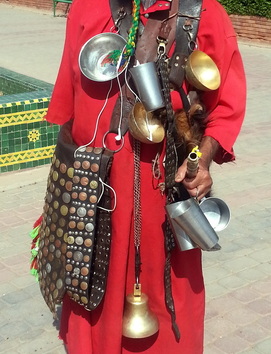 First of all we see the brass and tin cups. These were used by the customers to drink from. Long before "Reduce, reuse, recycle" these water-sellers were 100% eco-friendly. The water-seller carried water from cisterns in the outskirts of the city to the busy market areas. How did he carry the water? 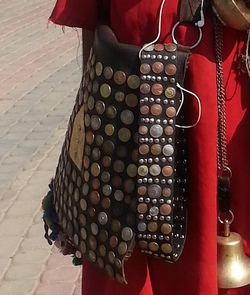 Look closely at the large leather pouch. It is probably made from goats leather, or it could be camel leather. It is specially treated to hold water (traditionally a goats bladder). The water seller often flavoured his water with mint leaves or lemon (to take away the taste of...). The water-seller also held his money in a pocket of the leather pouch. If he liked a coin or it was unusual he would stick it on the outside of the pouch. Over time, it became quite ornate. 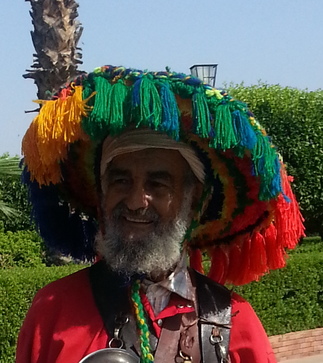 Working outside in the relentless Moroccan heat needs sun protection. This traditional Berber hat is eye-catching but it also provides good shade. 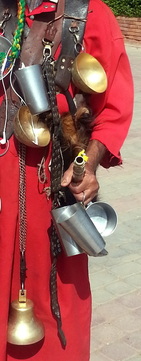 Finally, the water-seller has to make himself known to the medina. He uses rings his bell, toots his horn, sings, chants and sometimes dances. All around Morocco I encountered these entertainers. They were always brightly coloured, in traditional dress. Some don't wear the cups and bells anymore and focus more on their entertaining. Below is a very short video of one in Fez who knew a lot of English pop songs! The inside of the mosque is really ornate. Women and men pray separately. 5000 women can be accommodated in the balcony and 20000 men on the ground floor. These pools in the picture have glass bottoms and your can see down to the ablutions chamber below. When the roof is open, the water reflects the sky. In the columns around the hall, 360 speakers are camouflaged into the stonework. The Hassan II Mosque in Casablanca claims to be the 3rd biggest mosque in the world. It minaret (tower like part) is 210m high. 25,000 people fit inside to pray and 80,000 can fit on the courtyard outside. Muslims pray on a prayermat, so they need more than standing room. This mosque can accommodate more people than Croke Park! Hassan II Mosque is relatively new. It took 6 years to build and was completed in 1997. It had 6000 workers employed and they worked 24 hours a day by having 2 shifts. The mosque is named after King Hassan II. He decided to build it to commemorate his own 60th birthday. King Hassan II died just 2 years after the mosque was completed. The mosque juts into the sea. This is a man made peninsula because the Quran says that Gods throne was built upon water. Another interesting part if you look at the first photo is that the roof can open. There is no air conditioning in the mosque so during the summer, especially if the mosque is full inside, the roof slides open. For winter time when it's cooler, the mosque floor is heated. The ceilings are made of cedar wood because it is the best wood to use on a building beside the sea. There are intricate designs carved into the wood.
My first thought when I walked off the plane was of course - It's roasting! Morocco is actually an hour behind Ireland until the clocks change on the 19th of July for daylight saving. It is currently 10:30pm and it is a whopping 29° Celsius! My next impression was the driving. I had arranged an airport pickup with my hotel and there he was waiting for me in arrivals. We hit off for the short spin to the hotel on the crazy Moroccan highways. There are probably more scooters than cars, each scooter carrying at least one passenger. The general rules of these roads are : If there's a space - go for it 2 lanes means an automatic road race Indicator lights are unnecessary decorations It isn't quite India but it's best to focus on the scenery and not think about the other vehicles! Marrakesh from the (fast) moving car is very orange and sandy. All the buildings seem to be an orangey pink colour. Maybe it's the easiest to maintain with all the sand. We were driving in the suburbs and Ryad Dar Ouladna is in a newer area of the city. The buildings are spread apart and I only saw two people walking and they were tourists. It was about 8pm when I arrived at Ryad Dar Ouladna and the manager offered to drive me into the city if I wanted to eat. The restaurant was closed as it is Ramadan and the staff have their time off at that hour of the evening to eat and relax. Luckily I was not hungry and ready for bed. Due to Ramadan tourists are few. In fact, I am the only guest! The upside of this was my beautiful suite with a bathroom not much short of a leisure centre! The indoor dining / bar area The upstairs with carved wooden doors leading to each suite. The ensuite bathroom The suite complete with flat screen TV and balcony. And my breakfast table this morning beside the pool.
Breakfast was carb heavy, full of tasty sweet breads and pancakes. ( More about food in a later post.) Luckily the afternoon is too hot to eat and I followed local custom by eating dinner late in the evening. Overall, great first impressions : It's hot Driving is pure entertainment and at times terrifying Sweet cakes and pastries for breakfast The accommodation is amazing and I've gotten a taste of the Ryad/Medina style. It's beautiful. I'm sorry I can't speak French. English is useless here. Couscous will probably be my dinner every night. It's roasting! Ms Treacy is traveling! The journey to Morocco began this morning and will end tonight in
Palais DarOuladna, Marrakech. The itinerary for the next 3 weeks is as follows : Palais DarOuladna 2 nights Busabout Imperial Cities Tour 10 days Surf Berbere: Surf & Yoga 8 days And the last 2 nights are open to suggestions I gather along the way. My guidebook of choice is as always the Lonely Planet. What I know so far about Morocco courtesy of the Lonely Planet is:
|
Books To ReadThe Tenth Gift Jane Johnson
The Sultan's Wife Jane Johnson The Salt Road Jane Johnson A House in Fez Suzanna Clarke Ms Treacy RecommendsCategories
All
Archives
March 2017
|